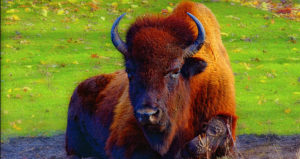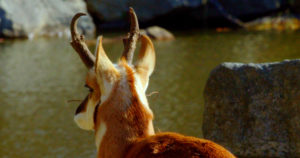By Freddy Moyano
With fall colors near their peak and temperatures dipping into the 30s earlier this month, I paid a visit to the NEW Zoo in Suamico to meet the five residents inside the Great Plains exhibit — a male and female elk, two female bison and a male pronghorn.
I was greeted and guided by Zookeeper Assistant Brent Koerner, who said he covers a variety of tasks at the zoo including cleaning up, feeding and assessing the animals.
While he covers all areas of the zoo on a relief basis, he mainly oversees the elk exhibit on Fridays.
Todd and Hummus
The NEW Zoo has two elks on exhibit, a 10-year-old male named Todd who came in 2013 and a 14-year-old female named Hummus who arrived in 2009.
Both came to the zoo at less than a year of age through private donations.
Koerner said zoo staff keep a safe distance from all five residents in the elk exhibit, especially during rut season.
“Todd is usually the boss. The bison go where he wants them to go,” Koerner said.
Koerner said enrichment activities are at the top of his list when it comes to favorite moments with the elks.
“I tossed some Christmas trees by the elk exhibit one day, and while I was cleaning in there, Todd was beating up one of them,” said Koerner.
According to worlddeer.org, elk antlers may weigh more than 40 pounds, and each antler may develop seven or eight points.
The animals will lose and regrow their antlers every year.
Unlike their caribou and reindeer cousins, only the male elk grow antlers.
They grow extremely quickly when they regenerate, and daily growth may be as much as one inch.
Longevity wise, Koerner said male elks live around 14 years on average, compared to females, which can live up to 24 years.
He said he suspects the difference between male and female life spans has something to do with the energy required for the males to regenerate and carry their antlers every year.
Regarding diet, Koerner said the elks get a special deer chow and wild herbivore chow in winter.
“During the spring, summer and part of fall, we will collect browse and phragmites in the woods for them,” Koerner said.
Koerner said elk are also known in the United States as wapiti, from the Shawnee and Cree languages.
He said in Europe, elk are called moose, so people get moose and elk confused at times.
He said that while elk have been reintroduced in the northern part of Wisconsin, they are more common in the Great Plains and many parts of Canada.
The other residents
The two female bison, Petunia and Clover, are among the other residents in the Great Plains exhibit.
Both have been with the NEW Zoo for about five years, according to Koerner.

He said they share about the same diet as the elk, with a barn area where they eat and take shelter.
The pronghorn, named Thistle, has his own separate feeding area in the barn to avoid confrontation with the other residents.
The pronghorn, which is not technically an antelope, is native to the Great Plains of North America.
He was very playful, constantly greeting me during my visit.
Koerner said the zoo used to have a female pronghorn, but she died years ago.
Koerner said pronghorns will drop their antlers once a year like elks.

According to the National Wildlife Federation, pronghorns are the fastest land animal in North America, capable of reaching speeds up to 60 mph.
The Suamico-based NEW Zoo & Adventure Park will see its hours change to 9 a.m.-4 p.m. Nov. 1 through March 31.
For more info, visit newzoo.org.
